Canon EOS 500D / Rebel T1i
-
-
Written by Gordon Laing
Canon EOS 500D / Rebel T1i Movie Mode
The EOS 500D / Rebel T1i becomes Canon’s second DSLR to offer HD movie recording, after the higher-end EOS 5D Mark II. Despite now having a dedicated movie position on the mode dial, the actual implementation is roughly similar on both cameras, although slower data readout from the 500D / T1i’s sensor, not to mention the use of potentially slower SD cards, means there’s additional limitations over the 5D Mark II to be aware of.
First is the actual quality: the 500D / T1i becomes the first Canon camera, DSLR or otherwise, to offer the choice of HD recording in either the 720p or 1080p formats. This is a considerate touch for those who prefer the longer recording times and more manageable files of 720p, but there are caveats involved with the higher of the two formats: the most obvious being the 1080p mode only records at 20fps, compared to 30fps for the 720p option.
Canon explained this was due to the limitations of the two-channel readout of the 500D / T1i’s sensor – it literally can’t get the data off fast enough to achieve 30fps at 1080p. Since 20fps isn’t quite quick enough for fluid motion in video, most will disregard this mode and treat the 500D / T1i as a 720p camera only, which brings it in line with the Nikon D5000. A second caveat involving 1080p is you’ll need a relatively quick SD card to record more than a few seconds of it. We were fine with an ageing SanDisk Ultra II card, but switching to a Silicon Power 45x card saw a buffer countdown appear on the screen with a maximum recording time of just eight seconds.
So is the 1080p mode useless? It depends on the subject and your expectations. We filmed the same panning sequence using the 720p and 1080p modes moments apart so you can judge for yourself. The 720p version is shown on the left, and registered members of Vimeo can download the original clips here: 720p version / 1080p version. You can also compare them against a clip filmed seconds later using the Nikon D5000’s 720p / 24fps mode here. It’s clear to see while 20fps is far from ideal when panning, some may find it acceptable for mostly static compositions.
The lack of ultimate smoothness at 1080p is undoubtedly frustrating, but a positive spin is to treat it as a high-speed continuous shooting mode rather than video: the individual frames may only be an equivalent of 2 Megapixels, but 20fps is certainly a quick burst capture rate. Ultimately though, the 1080p mode is hobbled and arguably only present here for marketing purposes. As far as we’re concerned, the 500D / T1i is a 720p model, and the use of ‘Full HD’ recording on adverts is a little misleading.
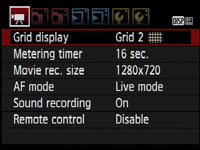 |
Either way, like all DIGIC 4 models, the video is encoded using H.264 and stored in a Quicktime MOV wrapper. Audio is recorded using a built-in mono microphone and encoded as uncompressed linear PCM, although unlike the EOS 5D Mark II, there’s no microphone input. As such, you will record sounds like the lens stabilisation, or adjustments of the focusing and zoom rings.
Like the EOS 5D Mark II, the 500D / T1i records video clips up to 4GB in size which by Canon’s figures, is good for around 12 minutes of 1080p / 20fps video, 18 minutes of 720p / 30fps, or 24 minutes of VGA / 30fps depending on the complexity of the scene. You’re looking at about 3.5Mbytes per second in 720p or just under 5Mbyte/s for 1080p, and a fully-charged battery should be good for about one hour’s worth of recording.
Sadly there’s still no manual control over exposure or aperture while filming video, so like the EOS 5D Mark II, it’s pretty much an automatic affair in this regard. In use both cameras avoid the audible switching of apertures as much as possible, but pan from dark to bright areas and you’ll see it suddenly jump from f5.6 to f16 with a click; thankfully you can lock the exposure though, using the ISO button. Under bright conditions there’s also still a habit for the camera to close the aperture right down to f16 or f22, which may ease focusing issues, but rules out a small depth-of-field outdoors and renders any dust marks quite visible.
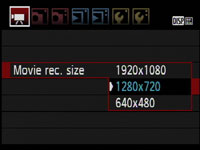 |
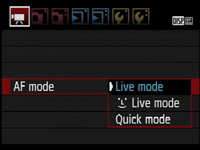 |
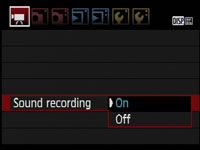 |
Speaking of focusing you can autofocus while filming, but like the 5D Mark II, this involves considerable compromise as it works no differently to auto-focusing in Live View when taking stills. As such you’ll need to hold down the AE / FE lock button and wait for a few seconds as the focus point leisurely shifts back and forth before locking-on – all while you’re recording. It’ll certainly refocus the lens, but unlike a camcorder it’s neither a quick nor continuous process. So while the 500D / T1i technically can autofocus while filming, most people will be setting it before recording or adjusting it manually like the Nikon D5000.
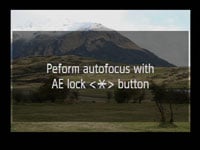 | 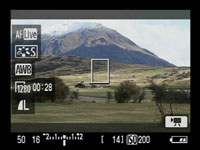 |
The results have the potential to look very good, but like all DSLRs with movie modes to date, you can forget about using it as a camcorder replacement for casual shooting; for the best results you’ll really need to understand the pros and cons of the system and how to get the best from it.
It’s also important to remember the DSLR form factor, not to mention its lenses, were never designed for filming video. DSLRs are not particularly comfortable to hold out in front of you for extended periods, and it’s almost impossible to twist the zoom or focusing rings without nudging or rotating the whole camera. Such adjustments, along with the IS system if enabled, will also be audible to the built-in microphone, and again there’s no option to connect an external model.
We should also mention that while the files will play back smoothly on the camera’s screen, you may have a very different experience when you get them on your computer. H.264 is a very complex compression system, and Canon implements it at very high bit rates. As such while you can simply drop the 500D / T1i’s MOV files directly into timelines of programs like Adobe Premiere, you won’t be enjoying real-time playback or responsive scrubbing while editing. To be fair, this is no different from editing AVCHD from a consumer HD camcorder, but it’s well worth knowing before buying.
With so many caveats, you may wonder if video recording on a DSLR is worth the trouble. Well if you’re a video enthusiast who’s willing to work around the issues to embrace the positive aspects, it certainly can be. DSLRs have a vast array of lenses available, including wide and long, macro and perspective control models, allowing a wide variety of effects.
DSLRs also have much larger sensors than typical camcorders, giving them the potential to perform better under low light while also allowing a small depth-of-field for selective focusing. To really exploit this in practice though you’ll need to fit an older lens with a manual aperture ring and bright focal ratio. If you use a modern lens (like the kit model) the lack of aperture control in the movie mode will frustrate you, while their relatively slow focal ratios compared to a typical camcorder will result in higher ISOs under the same dim conditions, losing much of the noise advantage of a bigger sensor.
So like all DSLRs to date with video capabilities, there’s a number of issues to be aware of, but still plenty of potential if you’re able to work around them. The higher-end EOS 5D Mark II still enjoys several key advantages including 1080p at 30fps, an external microphone input and of course a larger sensor allowing lower noise and a shallower depth-of-field. But equally this is a much more expensive camera. The 500D / T1i brings HD video to the more affordable end of the Canon range, and if you’ve ever tried editing 1080p on your computer, you may actually prefer its option to shoot in 720p instead.
PS – it is possible to take a still photo while filming – and at the camera’s full resolution if desired – although it’ll pause the video for around three seconds before starting automatically again. This gap is cut out from the final video file, although it may catch the sound of the shutter firing.




